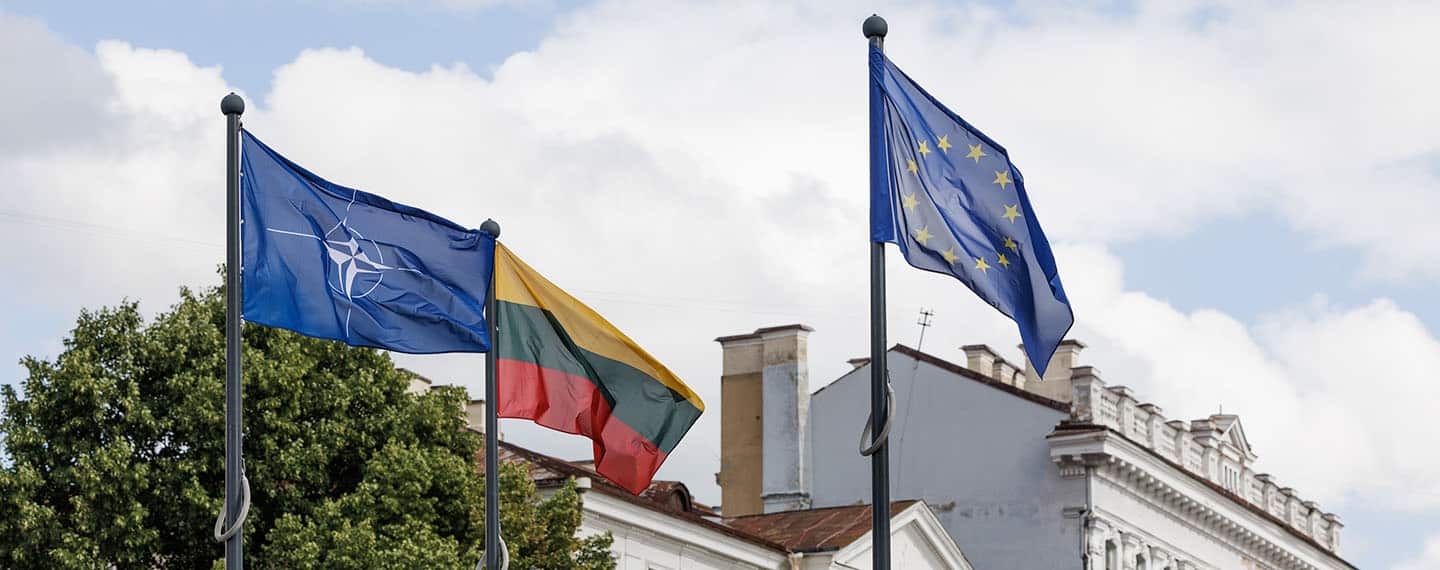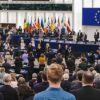Theme
This analysis examines how the NATO-EU relationship can be leveraged to advance two major strategic objectives: deterring further Russian aggression in Europe and assisting Ukraine’s defence.
Summary
The return of great-power competition has rendered the conceptual framework underpinning most discussions on NATO-EU relations obsolete. The need to assist Ukraine and deter further Russian aggression in Europe have become the over-riding strategic priorities for most NATO and EU member states. Against this backdrop, this paper examines how the NATO-EU relationship can be leveraged in pursuit of those goals. Luckily, NATO and the EU have complementary strengths. When it comes to deterrence –or, for that matter, assisting Ukraine– the Alliance has an advantage ‘downstream’, ie, in the direct implementation or operational aspects. The EU, for its part, has an advantage ‘upstream’, and can contribute to the resourcing and enabling of deterrence by helping generate the necessary technologies, capabilities and skillsets. This analysis calls for a full alignment between the EU’s defence instruments and NATO’s deterrence agenda and defence planning processes.
Analysis
Over the past two decades, discussions on NATO-EU cooperation have been closely associated with crisis-management operations out of area and the need to tackle threats of a predominantly transnational nature.[1] But that is yesterday’s world. NATO-EU relations cannot remain stuck in the strategic requirements of the 1990s.
The return of interstate war to Europe has underpinned a radical shift in European and transatlantic security priorities from transnational challenges and external crisis management to deterrence and defence in a great-power context, and a more immediate focus on assisting Ukraine. This has been recognised by both NATO and the EU. Even if neither the Alliance nor the Union have given up on other tasks such as crisis management operations out of area or cooperative security –at least rhetorically–, they have both shifted their attention towards deterrence and defence in a European context and assistance to Ukraine.
The return of war has put NATO back at the centre of European security debates and has led to a rebalancing of the Alliance’s own focus towards its first core task: collective defence.[2] This rebalancing began already post-Crimea, but it has taken a whole new dimension –and pace– after February 2022. The question of how to assist Ukraine has also been at the centre of NATO debates ever since.[3]
Interestingly, we see a similar dynamic at play in an EU context. In the last two years we have witnessed a significant shift in EU defence policy debates, from external crisis management and operations to the procurement of munitions and the capabilities required for defence proper, and to the mobilisation of the EU’s financial instruments to assist Ukraine and backfill European armaments stocks.[4]
What does this rebalancing towards deterrence and defence mean for EU-NATO relations?
While the topic of NATO-EU relations is a characteristically broad one, this brief focuses on its defence aspects, and more specifically on the question of how the EU-NATO relationship can be leveraged to fend off Russia’s assault on the European security architecture. This has been recognised as a top –if not the top– political and strategic priority by both NATO and the EU. However, recognition has not been adequately reflected in the NATO-EU agenda.
To be sure, the third EU-NATO declaration touches on Emerging and Disruptive Technologies (EDTs), mobility, partner capacity-building, resilience, space, hybrid or disinformation, all of which add value from the perspective of countering Russia’s threat to European security.[5] Even in these areas, NATO-EU cooperation remains lacklustre.[6] More importantly, however, the declaration arguably bundles all these things concepts with counter-terrorism, the climate-security nexus and other such transnational challenges. As such, NATO-EU declarations still bear a 1990s flavour, failing to establish clear priorities, and to afford deterrence the centrality it deserves.
As we move towards the Washington summit and beyond, towards a new EU institutional configuration, and in light of growing demands from Washington for Europeans to step up, I think the NATO-EU relationship should be laser-focused on deterring an attack on NATO/EU/Europe and on assisting Ukraine. These two problems are very much linked. Should Kiev collapse and fall within Russia’s strategic orbit –either completely or partially–, Russian forces would come in direct or almost direct contact with NATO territory. This means that the resourcing of deterrence alongside Europe’s Eastern Flank would become a lot more costly and complicated than it is at present, not least as the entire continental space running from the Baltic Sea to the Black Sea would be in play and would need to be resourced from a deterrence viewpoint. The fact that the bulk of Russia’s forces are pinned down in eastern Ukraine lowers the conventional military pressure across NATO’s eastern flank. This de facto turns Ukraine into Europe’s first line of defence.
But what does orienting the NATO-EU relationship towards deterring a Russian attack on NATO/EU/Europe and assisting Ukraine mean exactly?
Essentially it means establishing a direct connection between the EU’s defence instruments and NATO’s deterrence strategy and defence planning system. When thinking about deterrence and collective defence in a context of attrition and protraction, Europeans need to learn the lessons of what Russia is doing today in Ukraine by applying a strategy of exhaustion in terms of both resources and political will. That means coming up with operational concepts that can produce deterrence by denial, and the force structure, command and control arrangements and capabilities that can underpin deterrence by denial. But it also requires financial and industrial depth, and technological innovation.
Europeans need to think of deterrence as a whole-of-society effort. In that context, NATO and the EU should be conceived of as instruments at the service of the objectives laid out by the agents, ie, the Member States.
The NATO instrument has a competitive advantage downstream, ie, when it comes to the operational aspects or the direct implementation of deterrence. This is because of its state-of-the-art command and control infrastructure, its integrated defence planning process and its excellence when it comes to setting standards, not least through exercises and training. It is NATO that can best ascertain what kind of operational concepts, force structure, capabilities and skillsets needed to deliver deterrence; and to put them into practice.
But the EU instrument has a competitive advantage upstream, ie, in the resourcing and enabling of deterrence. Its operation of a substantial multiannual budget, its ample competences in areas like research, technology or industry, and its ability to mobilise instruments like the European Defence Fund, the European Investment Bank, Permanent Structured Cooperation, the European Peace Facility and a future European Defence Industrial Programme underscore the EU’s potential to help finance and generate the technologies, capabilities, and skillsets needed for deterrence.[7] Even if such technologies, capabilities and skillsets are eventually channelled operationally through NATO, the EU can play a critical role in generating them.
A similar logic can be applied to the assistance to Ukraine, even if it is the member states who are doing the bulk of the work. NATO has an advantage downstream. Short of providing Ukraine with operational assistance by way of Intelligence, Surveillance and Reconnaissance (ISR), target acquisition, etc –which the Alliance could do but has decided not to–, NATO can, through direct military dialogue with Ukraine, common training and exercises, help the country generate relevant concepts of operations, use capabilities and generate the skillsets needed for defence. For its part, the EU can help finance the acquisition of capabilities and skillsets by bringing Ukraine into its various defence instruments as part of its gradual accession process.
Conclusions
To recap, NATO-EU relations should be laser-focused on the core priority of defending Europe’s security architecture, which is currently under attack. This requires ensuring that the EU’s financial, technological and capability development instruments are deterrence-bound, and more specifically geared towards underpinning the operational concepts and capabilities identified by NATO. This would, in turn, require greater EU involvement in NATO’s defence policy planning process. A move in this direction would underscore the relevance of the EU’s defence agenda, strengthen the EU’s political and strategic leverage, reinforce NATO and advance the broader objective of transatlantic burden-sharing, which has now become a strategic and a political imperative.
NATO’s strategy is one of deterrence by reinforcement. And the EU’s financial and industrial instruments can provide the depth that NATO requires to sustain a long-term protracted campaign, which is key to deterrence.
[1] See, eg, Stephanie Hofmann (2013), European Security in NATO’s Shadow, Cambridge University Press, Cambridge; and Antonio Missiroli (2002), ‘EU-NATO cooperation in crisis management: no Turkish delight for ESDP’, Security Dialogue, vol. 33, nr 1, pp. 9-26.
[2] Luis Simón (2022), ‘The Madrid Strategic Concept and the future of NATO’, NATO Review, 2/VI/2022.
[3] For a more comprehensive analysis of NATO’s post-Crimea transformation see, eg, James Sperling & Mark Webber (2017), ‘NATO and the Ukraine crisis: collective securitisation’, European Journal of International Security, vol. 2, nr 1, pp. 19-46.
[4] For an overview of this process see Daniel Fiott & Luis Simón (2023), ‘EU defence after Versailles: an agenda for the future’, In-Depth Analysis, Directorate General for External Policies, European Parliament, Brussels; and Pierre Haroche (2023), ‘Arsenal Europe: financing military capabilities for Ukraine and EU Member States’, Policy Brief, Institut Jacques Delors, November.
[5] Joint declaration on EU-NATO cooperation, 10/I/2023, https://www.consilium.europa.eu/en/press/press-releases/2023/01/10/eu-nato-joint-declaration-10-january-2023/.
[6] Sean Monaghan et al. (2023), ‘Does the new EU-NATO Joint Declaration matter?’, Center for Strategic and International Studies, 13/I/2023.
[7] See Fiott & Simón (2023), op. cit., and Haroche (2023), op. cit.



